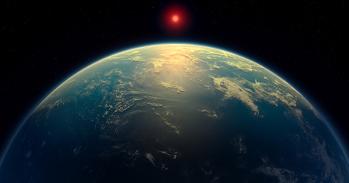
A European mission to explore how gravity, dark energy and dark matter shaped the evolution of the Universe soared into space from Cape Canaveral on 1 July.
A European mission to explore how gravity, dark energy and dark matter shaped the evolution of the Universe soared into space from Cape Canaveral on 1 July.
The Euclid mission will finally uncover the mysteries of how these ‘dark’ forces have shaped the cosmos that we see today, from life here on Earth, to our Sun, our Milky Way, our nearby galaxy neighbours, and the wider Universe beyond
Nicholas Walton
The Euclid space telescope will map the 'dark Universe' by observing billions of galaxies out to 10 billion light-years, across more than a third of the sky, to gather data on how its structure has formed over its cosmic history.
Led by the European Space Agency (ESA) and a consortium of 2,000 scientists, including from the University of Cambridge, Euclid will spend six years venturing through space with two scientific instruments: a UK-built visible imager (VIS) that will become one of the largest cameras ever sent into space, and a near-infrared spectrometer and photometer, developed in France. The mission is supported by funding from the UK Space Agency.
“Watching the launch of Euclid, I feel inspired by the years of hard work from thousands of people that go into space science missions, and the fundamental importance of discovery – how we set out to understand and explore the Universe,” said Chief Executive of the UK Space Agency, Dr Paul Bate. “The UK Space Agency’s investment in Euclid has supported world-class science on this journey, from the development of the ground segment to the build of the crucial visible imager instrument, which will help humanity begin to uncover the mysteries of dark matter and dark energy.”
Euclid took off on board a SpaceX spacecraft from Cape Canaveral in Florida at 4.11pm (BST) on 1 July.
Cambridge’s Institute of Astronomy team has been involved in Euclid since 2010, supporting development of the astrometric calibration pipeline for the optical image data from Euclid, ensuring that the positions of the billions of sources to be imaged by Euclid can be determined to exquisite accuracy.
“Dark energy and dark matter fundamentally govern the formation and evolution of our Universe,” said Dr Nicholas Walton from the Institute of Astronomy. “The Euclid mission will finally uncover the mysteries of how these ‘dark’ forces have shaped the cosmos that we see today, from life here on Earth, to our Sun, our Milky Way, our nearby galaxy neighbours, and the wider Universe beyond.”
The Science and Technology Facilities Council (STFC) also contributed to design and development work on Euclid instrumentation and provided funding to UK astronomy teams who will analyse the data returned from the mission about the physics responsible for the observed accelerated expansion of the Universe.
“This is a fantastic example of close collaboration between scientists, engineers, technicians, and astronomers across Europe working together to tackle some of the biggest questions in science,” said Mark Thomson, Executive Chair at STFC.
UK Space Agency funding for the Euclid mission is divided between teams at University College London, The Open University, University of Cambridge, University of Edinburgh, University of Oxford, University of Portsmouth and Durham University.
The wider Euclid Consortium includes experts from 300 organisations across 13 European countries, the US, Canada and Japan.

The text in this work is licensed under a Creative Commons Attribution-NonCommercial-ShareAlike 4.0 International License. Images, including our videos, are Copyright ©University of Cambridge and licensors/contributors as identified. All rights reserved. We make our image and video content available in a number of ways – as here, on our main website under its Terms and conditions, and on a range of channels including social media that permit your use and sharing of our content under their respective Terms.




